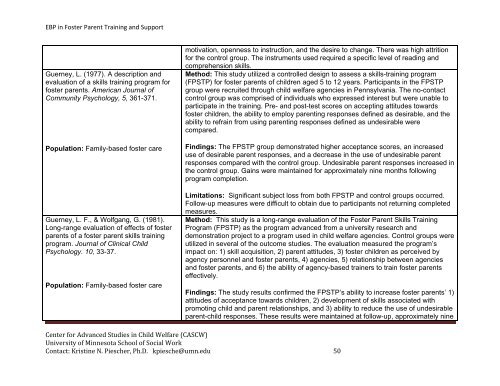Evidence-Based Practice in Foster Parent Training and Support ...
Evidence-Based Practice in Foster Parent Training and Support ...
Evidence-Based Practice in Foster Parent Training and Support ...
You also want an ePaper? Increase the reach of your titles
YUMPU automatically turns print PDFs into web optimized ePapers that Google loves.
EBP <strong>in</strong> <strong>Foster</strong> <strong>Parent</strong> Tra<strong>in</strong><strong>in</strong>g <strong>and</strong> <strong>Support</strong>Guerney, L. (1977). A description <strong>and</strong>evaluation of a skills tra<strong>in</strong><strong>in</strong>g program forfoster parents. American Journal ofCommunity Psychology, 5, 361-371.Population: Family-based foster careGuerney, L. F., & Wolfgang, G. (1981).Long-range evaluation of effects of fosterparents of a foster parent skills tra<strong>in</strong><strong>in</strong>gprogram. Journal of Cl<strong>in</strong>ical ChildPsychology. 10, 33-37.Population: Family-based foster caremotivation, openness to <strong>in</strong>struction, <strong>and</strong> the desire to change. There was high attritionfor the control group. The <strong>in</strong>struments used required a specific level of read<strong>in</strong>g <strong>and</strong>comprehension skills.Method: This study utilized a controlled design to assess a skills-tra<strong>in</strong><strong>in</strong>g program(FPSTP) for foster parents of children aged 5 to 12 years. Participants <strong>in</strong> the FPSTPgroup were recruited through child welfare agencies <strong>in</strong> Pennsylvania. The no-contactcontrol group was comprised of <strong>in</strong>dividuals who expressed <strong>in</strong>terest but were unable toparticipate <strong>in</strong> the tra<strong>in</strong><strong>in</strong>g. Pre- <strong>and</strong> post-test scores on accept<strong>in</strong>g attitudes towardsfoster children, the ability to employ parent<strong>in</strong>g responses def<strong>in</strong>ed as desirable, <strong>and</strong> theability to refra<strong>in</strong> from us<strong>in</strong>g parent<strong>in</strong>g responses def<strong>in</strong>ed as undesirable werecompared.F<strong>in</strong>d<strong>in</strong>gs: The FPSTP group demonstrated higher acceptance scores, an <strong>in</strong>creaseduse of desirable parent responses, <strong>and</strong> a decrease <strong>in</strong> the use of undesirable parentresponses compared with the control group. Undesirable parent responses <strong>in</strong>creased <strong>in</strong>the control group. Ga<strong>in</strong>s were ma<strong>in</strong>ta<strong>in</strong>ed for approximately n<strong>in</strong>e months follow<strong>in</strong>gprogram completion.Limitations: Significant subject loss from both FPSTP <strong>and</strong> control groups occurred.Follow-up measures were difficult to obta<strong>in</strong> due to participants not return<strong>in</strong>g completedmeasures.Method: This study is a long-range evaluation of the <strong>Foster</strong> <strong>Parent</strong> Skills Tra<strong>in</strong><strong>in</strong>gProgram (FPSTP) as the program advanced from a university research <strong>and</strong>demonstration project to a program used <strong>in</strong> child welfare agencies. Control groups wereutilized <strong>in</strong> several of the outcome studies. The evaluation measured the program’simpact on: 1) skill acquisition, 2) parent attitudes, 3) foster children as perceived byagency personnel <strong>and</strong> foster parents, 4) agencies, 5) relationship between agencies<strong>and</strong> foster parents, <strong>and</strong> 6) the ability of agency-based tra<strong>in</strong>ers to tra<strong>in</strong> foster parentseffectively.F<strong>in</strong>d<strong>in</strong>gs: The study results confirmed the FPSTP’s ability to <strong>in</strong>crease foster parents’ 1)attitudes of acceptance towards children, 2) development of skills associated withpromot<strong>in</strong>g child <strong>and</strong> parent relationships, <strong>and</strong> 3) ability to reduce the use of undesirableparent-child responses. These results were ma<strong>in</strong>ta<strong>in</strong>ed at follow-up, approximately n<strong>in</strong>eCenter for Advanced Studies <strong>in</strong> Child Welfare (CASCW)University of M<strong>in</strong>nesota School of Social WorkContact: Krist<strong>in</strong>e N. Piescher, Ph.D. kpiesche@umn.edu 50
















